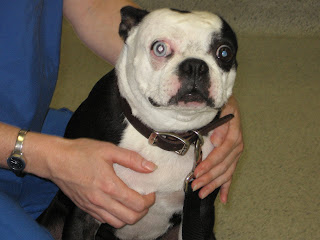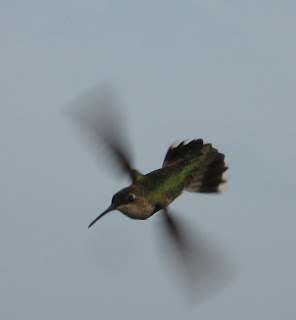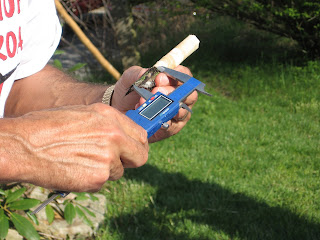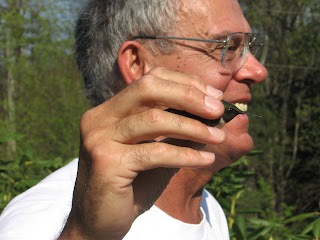First game of the season is at home against Youngstown State, Sat., Sept. 1 at noon.
Friday, August 31, 2007
GO BUCKS!
First game of the season is at home against Youngstown State, Sat., Sept. 1 at noon.
Thursday, August 30, 2007
Hummer Summer
I have had hummingbird visitors every summer since I moved here 10 years ago, but the population has soared in the past 2 years. I have discovered that the more feeders you hang up, the more hummers will come.

Both male and female Ruby-throated Hummingbirds are very territorial, and don't like to share their food source. One dominant male bird will monopolize a feeder, driving all his competitors away. For years, with only one feeder, I saw only a few hummingbirds. Greedy thing that I am, I wanted more.
I tried multiple feeders, separated by both distance and a visual barrier - one on the back side of the house, one on the front deck, one in a tree. I had more birds this way, as evidenced by the depleted feeders and the increased need for syrup, but I couldn't see them. I am only one person - I could only watch one feeder at a time. My hunger for hummers was not satiated.

Last summer, I hung two feeders on the front deck and one outside my bathroom window (my best bird-watching window; it looks out on all my winter feeding stations and my purple martin housing.) I had more hummingbirds than ever before. I felt like an explorer, discovering uncharted territory.

This April, at the New River Gorge Birding and Nature Festival, in West Virginia, I met Bill Hilton, of Hilton Pond. Bill is Mr. Ruby-throated Hummingbird himself. I had never met anyone so dedicated to the care and feeding of hummers. Bill not only educates people about hummingbirds, he bands them. (What a skill!)
One of Bill's tips was to put up several feeders in one location, on the theory that one bird cannot protect many feeders. If the resources are so great, there is no need to protect one little piece of turf, so more hummers can feed in peace. In the July/August issue of Bird Watcher's Digest, (the one with a painting of a phoebe by our favorite artist) there is an article by Bill Thompson, III (Bill of the Birds) with the same advice. Was it coincidence or did the two Bills have a chat?
I was convinced, and it worked! I currently have 4 (sometimes 5) nectar feeders hung from the gazebo of my front deck, plus one feeder at the bathroom window. Every day, I take down, clean, and refill at least two of them, and I make syrup two or three times weekly, storing the excess in the fridge till it is needed. I am going through a gallon of sugar solution a week (maybe more) and started buying sugar in 10 lb bags. Sitting on my deck in the morning or evening, I can count 15 hummers in view at once, but I know there are several more in the red maple, flying over the house or through the yard, and visiting the backyard feeder. A rule of thumb to estimate the total number of hummingbirds you have is to count the number of individuals you see at one time and multiply times 3. At this rate, I can easily guess my population to be 50 or more Ruby-throats living and working in my yard.
I am watching my hummers more closely as the season winds down. For one thing, I am having trouble with their gender. The adult male is unmistakable, with his red gorget and notched tail, but the juvenile males are hard to distinguish from the females. Both have rounded, white tipped tail feathers, and if I don't pick up on the faint streaking in the throat, I have a hard time telling the young boys from the girls.
I'm also studying all these hummers with an eye toward finding a rarity. While Ruby-throated Hummingbirds are the only species which lives and breeds in Ohio, Rufous Hummingbirds are becoming more common in fall migration. Now that my numbers are up, I'd love to have a new species of hummer visit me. I'm still greedy when it comes to these tiny birds.
Wednesday, August 29, 2007
Emergency Vet
It was just 6pm and we were closing up after a fairly slow day. My technician was discharging the last patient and I was writing up my charts while the kennel assistant waited for her chance to mop the front floors. Suddenly I heard, "Doc, we have an emergency up front!"
I ran to the front to find a man struggling to get a German Shepherd through the door. She had collapsed literally on our doorstep. I helped him into an exam room and asked "What's the problem?" She was wet, and I was guessing that she must have had a heat stroke (It was over 95 today) and they had wet her down before bringing her in. Wrong. Turns out they had been bathing her outside by their back fence when she was attacked by a swarm of yellow jackets.
I started my assessment immediately - gum color, capillary refill time, heart rate - all within normal range. Respirations - a little rapid, OK. She was recumbent and not very responsive, which worried me. But, my biggest concern --- she was covered in yellow jackets. Several had flown off when she entered the building and were buzzing around my reception area, causing the two young boys of the family to scream and cry. I killed 4 that were in her ear, and many more from her body. All told, we removed close to 2 dozen yellow jackets in the office, and I don't have a clue how many stings she must have had - dozens for sure, maybe hundreds. Who had time to count?
My tech followed me into the room and we completed our triage and had an IV catheter going within 5 minutes of the dog entering the building. Intravenous steroids and antihistamines, plus shock rate IV fluids soon had her coming around - sitting up on her chest and looking more alert. I didn't feel it was necessary to give her epinephrine, as she was responding so well, but I advised the owner that we weren't out of the woods yet.
Yellow jackets aren't like bees, which die after stinging once. They are able to keep on stinging, and part of treatment is to try to find and remove every last insect. Tough to do in a thick coated dog, with two worried adults and two freaked-out children to deal with. My emergency drugs were keeping the worst of the reaction away, but I knew they would wear off soon, and that the dog needed additional treatment and continued monitoring. We got the dog stable and sent her on to the local 24 hour emergency service for intensive overnight care. I hope she does well: The last dog I saw that was this badly affected died despite our best care.
This story emphasizes the benefit of overnight and 24 hour veterinary ER's. In the old days, I would have stabilized the dog, left her on IV fluids overnight, and prayed that she would be alive in the morning. Now, I consider "emergency care" that consists of the vet coming in, hospitalizing the pet and going home to bed as tantamount to malpractice. I know there are areas of the country that don't have 24 hour facilities readily available (I have lived and practiced in several such areas) and I know that vets do the best they can. I personally have made many late night trips to check on critically ill pets or napped on the floor near unstable patients in the past. I also know that I don't miss the lack of sleep, the worry wondering if there was something else I could have done, or the sick feeling of coming in to work the next morning to find a pet "dead in cage."
Two lessons from tonight's event: 1) Yellow jackets can cause life-threatening toxicities and 2) When your vet refers you to an overnight or 24 hour emergency service, it is because s/he has your pet's best interests at heart.
Update, Thursday, 5pm: Tia is doing well. Although I was off today, I couldn't wait to hear about her and called the emergency practice at 8am. She lived through the night, and was expected to be discharged today. Hip, hip, hooray! A "save" always makes me feel good.
Tuesday, August 28, 2007
Toxicology Tuesday, August 28
What do all these products have in common? Each of the above items (except the Hartz product) contains 45-65% permethrin, a synthetic insecticide. (The last item contains phenothrin, a similar agent.) Permethrins have a good margin of safety in dogs, but even a small amount of any of these products are TOXIC to cats.
Pyrethrins are the natural pesticides derived from chrysanthemum flowers, which are very safe and which break down quickly. They can be used in cats and young animals with little to no risk of injury. (Note: Anything is potentially toxic to an animal with a sensitivity to that agent.) Man-made pyrethoids like permethrin last a lot longer and are safe for dogs. The packages always bear warning labels saying not for use in cats, though some are more obvious than others. There are at least 18 different permethrin products available, and it doesn't matter if you get one from a veterinarian, the Internet, a pet store, or any other source - permethrins extremely toxic for cats.
Other cases are the result of accidental application, or rarely by cats coming in close contact (grooming, cuddling) with dogs who have had these products applied. My cats frequently snuggle up with my dogs – I won’t have a permethrin product in my house.
Signs may appear within a few hours but can take up to 72 hours to show up. Muscle tremors are most common, and seizures may occur. With aggressive (and expensive) treatment (decontamination, IV fluids and medications like methocarbamol for tremors and diazepam for seizures) the prognosis is good.
Monday, August 27, 2007
Dog Days
My dogs have never been to a dog park, and so were a bit cautious about venturing too far away at first.
But, they soon began making friends - both canine and human.
We all had a great time, though Grace didn't know when to stop retrieving tennis balls, and was very stiff and sore Sunday night.
Friday, August 24, 2007
New Albany Classic

As well as enjoying a great day, you will feel good knowing that your admission fees go to support the Columbus Coalition Against Family Violence, which I think you will agree is a worthy cause. There are no ticket sales at the gate; be sure to buy your tickets early. (See above link for details.)
This year is the 10th anniversary of the New Albany Classic. My sister and I have been going for the past 4 or 5 years, and every year, it gets more popular. The morning starts out with the OSU Marching Band (The Best Damn Band in the Land!) and cheerleaders, and Jack Hanna and the animals of the Columbus Zoo, continues with musical entertainment, rides, games and face painting, and booths supporting various animal causes, moves to great food including Graeter's ice cream, and ends with the grande finale, the jumping, which runs from 2:30 to about 4:30pm.
To whet your appetite, here are photos from last year's event.

Thursday, August 23, 2007
Dog Training Books
I showed you this book once already - "A Dog in Hand," by Dr. George Gates. It is not well known, and it should be. He has some theories on handling young puppies that are very similar to what I presented in Puppy Handling part 1 and part 2. Read this one for many practical tips and useful insights into dog behavior.
This link will take you to Ian Dunbar's Sirius Puppy Training site. He has excellent videos demonstrating positive reinforcement training techniques like I showed for Sit, Stand, and Down. Dr. Dunbar invented the concept of puppy "kindergarten" classes that promote socialization and teach basic manners, including bite inhibition, for puppies 2 to 5 months old, using food lures and praise.
Pretty much my "Bible" of dog training is Carol Lea Benjamin's "Mother Knows Best, the Natural Way to Train Your Dog." It's an old book, published in 1985 by Howell Book House, but still rings true today. Even though I practically have it memorized, I always re-read it when I get a new puppy. Her concept of Alpha equals Mother, not Dictator, and her simple line drawings illustrate each point with easy humor. She has several companions books, like "Dog Problems" and "Second Hand Dog" (about training a dog who comes with baggage) but read "Mother Knows Best" first.
Another classic is by the Monks of the New Skete Monastery, "How to be your Dog's Best Friend." The monks raise very high caliber German Shepherd Dogs in upstate New York, with an emphasis on physical and mental health and excellent behavior. This book was originally published in 1978 by Little, Brown. If you own or purchase a copy of this book, do me a favor: Go to page 47 and tear it out. This is the infamous "alpha roll," which should be outlawed, in my opinion. The primary author of the book, Job Michael Evans, said in later years he wished that technique had never been included in the book.
What's wrong with the "alpha roll?" Aside from the fact that it could get you seriously hurt if you did it to the wrong dog, and excluding the point that most people have no clue what they are doing and misuse it, the bottom line is dogs (or wolves) don't roll each other over. In wolves in the wild, even in dog society, a submissive animal offers the roll-over to signify his acceptance of a dominant animal's status. A respected leader doesn't go around knocking his subordinates over - it is beneath his dignity. When you roll your dog or puppy over and scream in his face, you look maniacal, like someone who should be feared or shunned, not like someone who should be trusted and followed.
So, drop the alpha roll-over from your repertoire immediately and as a matter of fact, be very careful with the "shake-down" demonstrated on page 45, too. I do use the shake technique with my very pushy, mouthy puppies who insist on biting me, but I pick and choose my cases carefully. I even used it on a 120 lb male Rottweiler in the exam room once. He needed an upper respiratory virus (kennel cough) vaccination which is given as nose drops, and he didn't want it. He was not being mean, just stubborn, and kept shaking his head back and forth ("no, no, no, no.") The owner, a strong man in his own right, was trying to hold him still, and the Rott was shaking him around the room like a rag doll. Finally, in frustration, I grabbed the dog by his jowls, lifted his front feet off the floor, gave him a firm shake, a hard eye, and a growl: "Quit it!" I set him down hard and he blinked once and looked completely dumb-founded. I proceeded to give him his vaccination without any holding, any head shaking, or any trouble.
I don't advocate that you try this with just any dog, and in retrospect, I told myself sternly what a stupid thing this was for me to have done. Had he been a mean or difficult dog, he could easily have killed me. I was lucky that I read the dog right and was appropriate in my level of correction, because to have been too hard or too soft on him would have made the matter worse. Still, I do have fond memories of that appointment.
Back to books:
Although "How to Be Your Dog's Best Friend" was credited to the entire monastery, the primary (pretty much only) author was a young monk named Job. After leaving the monastic life, Job Michael Evans moved to New York City and set up a dog training business, "The Patience of Job," based on the techniques he learned at New Skete. He wrote several books, including "The Evans Guide to Housetraining," "Civilized City Canines," and "The Evans' Guide for Counseling Dog Owners." He also gave seminars, and I was lucky enough to attend a two day class he gave in Cincinnati. My dog Joshua was a demo dog, and Job complimented Josh on his brains and training, even giving him a kiss on his forehead, at the "third eye," which Job said he reserved for dogs who had accomplished something special. I was very saddened when we lost this soft-spoken, gentle man to AIDS.
Don't let the title fool you: "Evans' Guide to Housetraining" is about more than when and where to go poo or pee. It is about nutrition and parlanguage and being alpha. The author says it best in his introduction: "Please don't view housetraining as an isolated process with one magic solution ..." something I tell every dog owner who asks me how to get Fido to stop barking, biting, jumping up or peeing on the carpet.
Jon Katz's book, "Katz on Dogs" (Don't you love that title?) isn't so much a training book - not a lot of "This is how you teach Down or Stay" - but a philosophy-of-training book. I know he has written several books, but this is the only one I have read so far. I like his style. He makes me feel like it is OK to mess up, that I won't ruin my dog if I make a mistake. So many people tell you to "always" or "never" do this or that, and Katz confesses that he is human and sometimes he does yell at his dog over nothing or punishes it when it comes back after having run away. Read Jon Katz and you will immediately feel better about yourself.
Elizabeth Marshall Thomas' book, "The Hidden Life of Dogs" is a fascinating look into what dogs do when we aren't around to control their every move. Although I oppose her method of study (letting dogs run loose and following them as they roam over 130 square miles is too fraught with potential danger in my opinion) it is amazing the things dogs do when they are on their own. Thomas also has experience with wolves and dingoes, and does a nice job of "compare and contrast" between the behaviors of three Canids.
One of my favorite examples from her book is her discussion on how we give our dogs commands. Remember back to Rule #3 of my Rules for Dog Training - "Dogs don't speak English" and it's corollaries: "Say it once," "Say it the same way," and "Say it softly." No matter how many times I tell a person that, I still hear "sit, Sit, SIT, SIT!" Why do we repeat ourselves and get louder each time, even when we know we shouldn't? Because we are primates, and when primates get excited, they repeat sounds over and over, with increasing volume. As humans, masters of the spoken language, we are proud of our wide vocabulary. Why use one word when 6 might be better? So, we say "Come," "C'mere," "Come over here," "Come here right now," and so on. Imagine if you were plunked down in the middle of a foreign land and someone kept on jabbering at you, with many different sounds and no hand gestures. Would you ever get the concept the stranger was trying to get across to you?
These and many, many other situations in her book struck home with me. If you would like a unique perspective on the human at the other end of the leash, read this book. But, be sure to bring along a sense of humor and be prepared to laugh at yourself.
Before you ask, yes, I have read the book by a popular TV dog trainer, and so far, haven't found it worthy of my library. It is mostly a rehash of the alpha concept, which is hardly new, with a fair amount of celebrity name-dropping, which doesn't impress me. One concept which I do find useful is the idea that our dogs need much more exercise than they get, and that the exercise should be structured. However, maybe one in 100 people could give their dogs the hours of daily exercise advocated in this book, and I suspect most people ignore this advice out of hand. The author's habit of taking a pack of dogs for a walk or roller-blading with dogs is ill-conceived. Maybe some people can do this, but I fear most cannot, and mayhem and injury are likely to occur if untrained owners attempt these tricks.
Looking for an end-of-summer read? Try some of these dog books, if you would like to understand your four-legged buddy.
Monday, August 20, 2007
Toxicology Tuesday, August 21
Answer: Not toxic.
The brand names may vary and the containers might be called discs, chambers, traps or systems, but as a general rule, ant and roach baits are nontoxic. In the past, these products contained poisons like arsenic. Now, the industry uses much safer insecticides - boric acid, fipronil (the active ingredient in Frontline), or avermectin (similar to the ivermectin in Heartgard) - which are specific to insects and don't affect mammals. The low concentration and small amount of the insecticide in the bait means pets are at very low risk of poisoning. The plastic or metal container is actually more dangerous than the bait, as it could pose a risk of GI obstruction. Check with your vet if your pet develops vomiting or other signs of illness, but otherwise, not to worry.
Friday, August 17, 2007
Baby Faces
I tried like anything to get a better picture of her face,
but all she wanted to do was sniff the camera lens.
An Australian Shepherd. Note the heterochromatic eye (mixed brown and blue)
That is a trait commonly seen in dogs with merle patterns
(Shelties, Aussies, I even have a blue merle Dachshund patient.)
Is there anything cuter than a kitten?
Yes, TWO kittens!
They are supposed to be some kind of rare cat breed,
but they just look like tabby kittens with little stubby tails to me.

Check out that blue eye.
They have cat litter in their fur from playing in the litterbox.
She had a "cherry eye" surgery two weeks ago and then I spayed her today.
She feels very sorry for herself, and she hates her satellite dish.
Please don't mock.
1 year old Cavalier King Charles Spaniel, aka "Cav."
I don't know why he looks so miserable in this picture.
I couldn't get him to smile for me.






